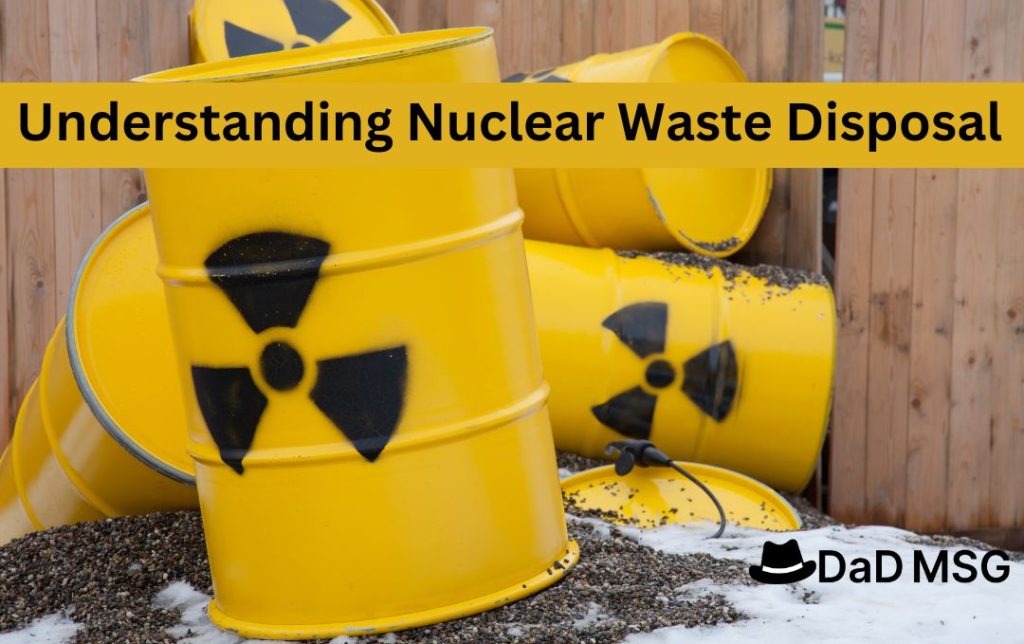Nuclear Waste Processing
Nuclear energy production has been a crucial source of efficient and clean energy, but it also generates a sizable byproduct known as nuclear waste. It is essential to manage and dispose of this trash properly to protect both current and future generations. In this blog article, we will examine the procedure for disposing of nuclear waste, illuminating how it is handled, where it travels, and what happens to it.
- Cooling: The used fuel is initially kept in cooling ponds or dry storage facilities after being removed from the reactor. As a result, the fuel’s radioactivity is reduced and it can cool down.
- The fuel is then dissolved in a specialised chemical solution, usually nitric acid, in the following stage. The desirable components, such as uranium, plutonium, and other valuable materials that may be employed in subsequent fuel cycles, are separated from the fuel using this procedure.
- The desired elements are subsequently extracted and purified from the dissolved fuel solution using a variety of chemical separation processes. These procedures frequently use solvent extraction or ion exchange techniques, in which the valuable components are selectively separated from the trash using particular chemical agents.
- The recovered components, such as uranium and plutonium, can be transformed into a form that is appropriate for reuse, frequently by being transformed into new fuel elements or blended with other substances.
- Waste management: After valuable materials have been removed, a mixture of radioactive isotopes and other waste products is what is left over. To stop radioactive components from dispersing during long-term storage and transportation, this low-level waste is often consolidated and enclosed in a stable matrix, like glass or ceramic.
Where Does Nuclear Waste Go?
Where does nuclear waste go after processing is finished? is a valid question. Nuclear waste can be divided into two categories: high-level waste and low-level waste.
HLW, or high-level waste HLW requires specialised and secure storage because it is both extremely radioactive and long-lasting. Deep geological repositories are one extensively used strategy (DGRs). These repositories are built several hundred metres below the surface, deep underground, in solid rock formations. To ensure that the chosen site is stable and isolated, thorough geological assessments are conducted there. DGRs for nuclear waste have been established in nations like Finland and Sweden, among others.
DGRs keep the waste in specifically created, corrosion- and leak-proof containers constructed of sturdy materials. The environment is shielded from potential radiation emission by the geological formations surrounding the repository. The waste’s radioactivity diminishes with time, making it less dangerous for both people and the environment.
Low-Amount Waste (LLW): Depending on its features, LLW, which has a lower level of radioactivity, can be disposed of in a variety of methods. Until it degrades to an acceptable level, some LLW can be safely and securely kept on-site in facilities that were built for the purpose. Other LLW undergoes suitable treatment and can be disposed of in facilities that are permitted and controlled to handle such waste, such as contaminated clothing, tools, or building materials.
What Happens to Nuclear Waste?
Nuclear waste’s long-term fate is determined by its radiation level and the disposal procedures used. High-level waste is kept separated and under close observation in deep geological repositories, as was previously described. The radioactivity of HLW waste gradually diminishes over time due to a process known as radioactive decay. This implies that over time, the waste’s radioactive isotopes eventually decay into stable, non-radioactive elements. How quickly these isotopes degrade to a safe level is determined by their half-lives.
The extended half-lives of the radioactive isotopes in high-level waste are taken into consideration when designing deep geological repositories. The repository offers a secure setting where the waste can be safely kept for a long time until its radioactivity is reduced to a level where it no longer constitutes a serious concern.
The repositories are regularly inspected to make sure that any possible problems or alterations to the storage environment are quickly identified. This enables the necessary modifications and actions to preserve the storage facility’s integrity and stop any potential leaks or releases of radioactive materials.
Regarding low-level waste, the disposal procedures change based on the nation and the particular waste classification. In specially designed storage facilities on site, some low-level trash can be securely kept. These structures are made to stop radioactive materials from leaking into the environment.
Before being disposed of, other low-level waste kinds could additionally go through processes including compaction, incineration, or encapsulation. After being treated, the waste is subsequently disposed of in facilities that are specifically designed to keep radioactive materials contained for the long term.
It’s crucial to remember that the disposal of nuclear waste is a carefully regulated procedure that adheres to tight laws and global standards. In order to preserve the environment and the general public’s health, governments, regulatory agencies, and international organisations collaborate to create and implement these policies.
Read More:- Reaching New Heights: Unveiling the Extraordinary Empire State Building
Conclusion
The removal of nuclear waste is a difficult and crucial task designed to protect our future. The leftover waste is processed, encapsulated, and kept in specialised facilities while valuable materials are removed from and utilised with nuclear waste processing.
High-level waste is kept in stable rock formations deep underground in deep geological repositories since it is both extremely radioactive and long-lasting. The repositories operate as a natural barrier to stop the release of radioactive materials as the waste gradually degrades over time.
Low-level waste, which contains less radioactive, can either be held locally or treated further before being disposed of. The disposal strategies are determined by the particular waste classification and are intended to stop the release of radioactive elements into the environment.
We can assure the safe storage and disposal of nuclear waste and reduce the hazards to human health and the environment by putting in place strict rules, ongoing monitoring, and international collaboration.
Finding novel and long-lasting methods for managing nuclear waste is a research and development priority as nuclear technology continues to evolve. We hope to further improve the safety and effectiveness of disposing of nuclear waste through continued scientific discoveries, paving the path for a cleaner and more sustainable energy future.
Read More:- Centrica’s Ceo Is Encouraged To Forego A £1.6 Million Incentive, But He Won’t Talk About It.




